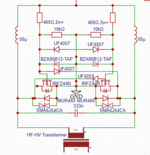MarcusFunt
Newbie
Hi!
I am building a device for a national competition ("Unge forskere") That should be able to sterilize hands with nothing but electricity.
For this project, I need a High-Voltage power supply, capable of delivering 12(or so)kV at 30-100khz.
Therefore my head automatically went to the very popular "ZVS driver" because I want a very efficient operation without much heat as it will be placed in a closed box.
You can look at my current schematic in the attached picture.
I modeled the schematic in lTSPICE and found that 71v spikes occur at startup, and therefore can't use the 60v IRFZ44N I originally wanted to use.
Now the problem is that I don't know what other MOSFET I can use.
I don't care if it is SMD or THT.
I found a few FETs I think will work, but I'm not certain
Any help, both with MOSFET choice and flaws in my design is greatly appreciated
I am building a device for a national competition ("Unge forskere") That should be able to sterilize hands with nothing but electricity.
For this project, I need a High-Voltage power supply, capable of delivering 12(or so)kV at 30-100khz.
Therefore my head automatically went to the very popular "ZVS driver" because I want a very efficient operation without much heat as it will be placed in a closed box.
You can look at my current schematic in the attached picture.
I modeled the schematic in lTSPICE and found that 71v spikes occur at startup, and therefore can't use the 60v IRFZ44N I originally wanted to use.
Now the problem is that I don't know what other MOSFET I can use.
I don't care if it is SMD or THT.
I found a few FETs I think will work, but I'm not certain
FDP085N10A-F102
NTP011N15MC
Any help, both with MOSFET choice and flaws in my design is greatly appreciated
